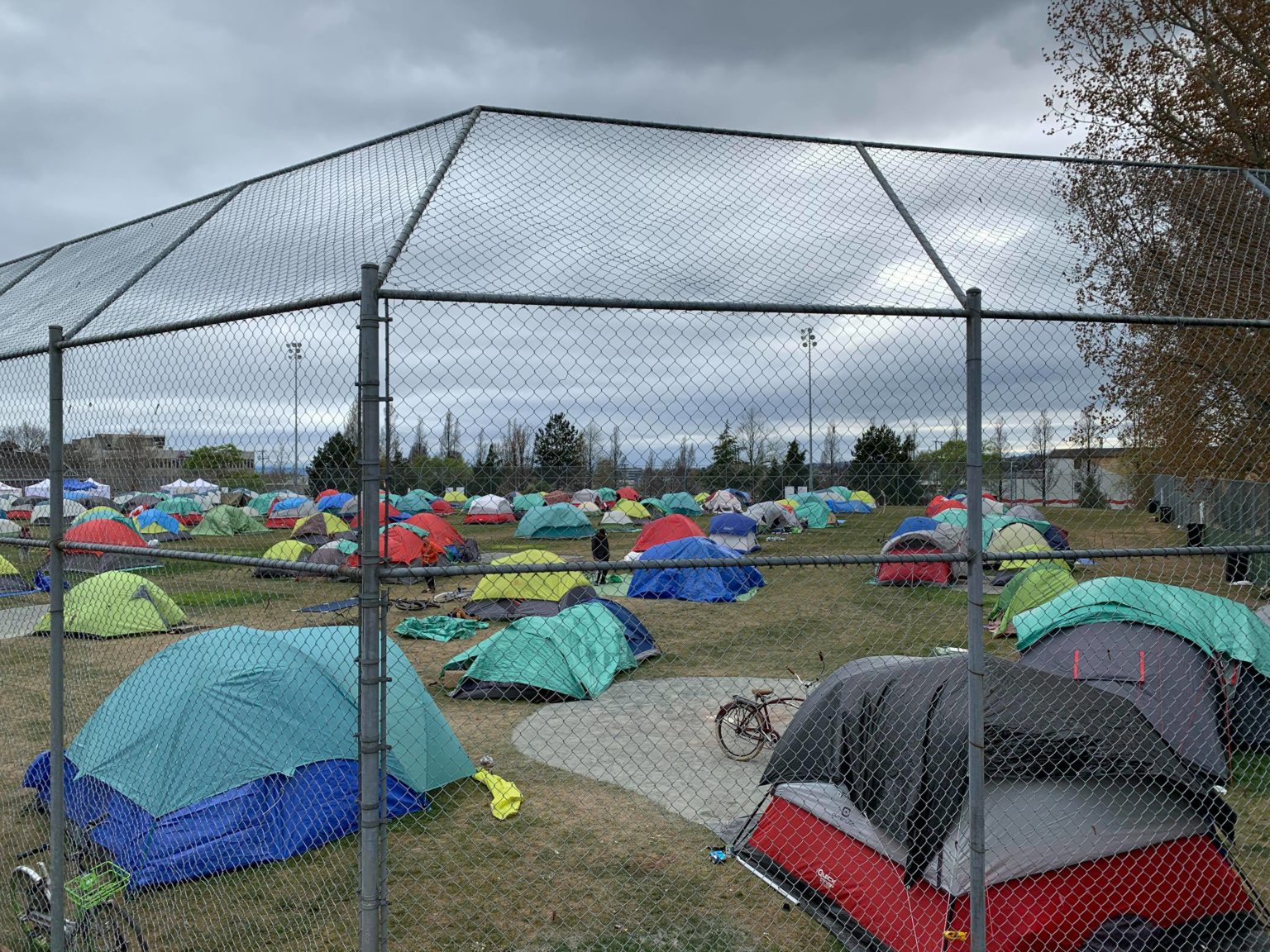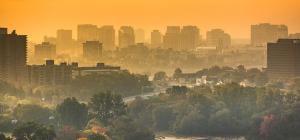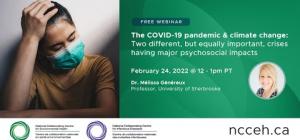
Environmental public health guidance for encampments during the COVID-19 pandemic

To prevent the transmission of SARS-CoV-2, the coronavirus that causes COVID-19, public health guidance promotes physical distancing, staying home when ill, good hand hygiene and environmental cleaning. The measures to reduce community-wide COVID-19 spread have also resulted in social supports being limited to people due to closures or limitations in their operations. For those most vulnerable in our communities, such as those experiencing unstable housing or homelessness, there appears to be clustering in encampments around the remaining services and for safety.1 While they vary in size, encampments refer to any area where a group of people live together, often in tents, temporary structures, vehicles, or other forms of informal shelter.2 The term encampment itself has connotations of both impermanence and continuity.3 For those in an encampment without water or hygiene and sanitation facilities, the challenge to follow public health guidance is compounded.
Environmental Health ensures clean water, food, air, and living environments.4 As such, this guidance document supports environmental health practitioners’ response to encampments during the COVID-19 pandemic. The target audience is Environmental Health Officers (EHOs), although other health professionals, local governments, housing agencies and social service providers may also find this resource useful for their planning of services. This guide features environmental health protection and planning related to issues in encampments. Considerations for operations on hygiene, cleaning, and physical distancing are summarized. In addition, effective channels of communication and an emphasis on longer-term sustainable housing solutions are needed to reduce the occurrence of environmental health issues.
Baseline health and homelessness
The State of Homelessness in Canada 2016 report estimated that 35,000 people are experiencing homelessness on any given night in Canada.5,6 It is well documented that the natural lifespan can be reduced by 40% for those who live on the streets compared to those living in a home.7,8 Furthermore, for those experiencing homelessness, 65 years and under, all-cause mortality is 5–10 times higher than those in the general population.6,9 When compared to the rest of the population, those who are homeless have higher rates of premature mortality, especially from unintentional injuries and suicide, and an increased prevalence of a range of infectious diseases, mental health disorders, and substance misuse.10,11 People become homeless through a complex interaction between individual and structural factors (e.g., poverty, health, substance misuse, violence, and unemployment). Homelessness can be a long-term state or a temporary transitional period related to circumstances such as domestic violence.12
Unstable housing can enhance COVID-19 transmission risk
People who are experiencing homelessness (or living in transitional housing) often have compromised immune systems and may be at an elevated risk for viruses like COVID-19.13,14 They may also be at higher risk of developing complications due to COVID-19, as they are more likely to report having an underlying chronic condition (particularly asthma, chronic obstructive pulmonary disease, and heart conditions) compared to the general population.15 The Public Health Agency of Canada and other public health organizations have provided further rationale below:
- Barriers to accessing traditional health services and social service provider resources.
- People experiencing homelessness may experience challenges receiving or following public health advice due to reduced social and communication interactions, including being able to effectively quarantine (self-isolate), isolate, or practise physical distancing, and perform proper hand hygiene.15
- The risks are amplified by congregate or transient living that can promote the transmission of SARS-CoV-2.16
- Those who are experiencing homelessness may have increased exposure to others as they move between locations.15
- Because many who already feel marginalized or stigmatized, or have undergone trauma, may not seek treatment, follow medical advice, take precautions or care for themselves or others, this may amplify transmission.
- There are underlying difficulties accessing shelters, which have been compounded by guidance to limit the crowding in over-capacity shelters, “decanting” or “thinning” (essentially relocating) people into other facilities, and/or leaving some without shelter.
- There are those who do not feel comfortable sheltering indoors due to previous experiences of violence in indoor shelter sites.
- There have been outbreaks or clusters of COVID-19 (and Hepatitis A) in the homeless population in shelters in Seattle,17 Montreal,18 Toronto,19 and Calgary.20,21
An important distinction is that although people living in encampments may be homeless, they may not be. They could be fleeing domestic violence or experiencing job layoff or loss; they could be runaways or veterans in poverty, underemployed, seasonally employed, bottle collectors, street vendors, day labourers, an encampment supporter, or transient.22
Environmental health concerns in encampments
The role of Environmental Health Officers (EHOs)
EHOs investigate public health hazards and are responsible for carrying out measures for protecting public health. They administer and enforce provincial (or federal, when applicable) legislation related to environmental health, to keep water, food, land, and air safe.25,26 They are delegated their role under the Medical Health Officer and derive their duties respectively from the Public Health Act. While an encampment is outside an EHO’s typical day-to-day inspections, they can be called on to review or inspect encampments, offering guidance to reduce environmental and community-acquired disease transmission. In response to COVID-19, some of the expertise they may provide includes (but is not limited to):
- Consultation regarding location, site plan, and operations for environmental health concerns (i.e., physical distancing, hygiene, sanitation, food safety, drinking water and infection control).
- Conducting inspections to provide environmental health recommendations and minimize related risks.
- Supporting Emergency Response Centres as an active participant, environmental health content expert, or liaison representing the public health department.
- When available, offering best practice priorities for safe decampment into alternate housing.
- Advocating for longer-term solutions (e.g., specialized, supportive, and good-quality housing for all) in line with core EHO competencies27 and Healthy Built Environment (HBE) programming.28
EHOs have proficiencies in the topic areas listed that are of particular relevance and concern in encampments. Their recommendations must be specific to the site, scope of operations, and jurisdictional differences in health legislation; therefore, this list does not delve into specifics. However, if local resources are not available, detailed-oriented advice can be found at the Pan American Health Organization, Public Health Agency of Canada, or King County Health Unit, which offer foundational Environmental Health guidance.
- Potable water: Ensure safe and secure water supply access for domestic purposes including for drinking and sanitation onsite or at a nearby public facility.1
- Liquid waste: Make proper waste disposal available (appropriately sized and inclusive of grey water) in the form of porta potties and/or washrooms, 1 per 20 users.29
- Solid waste: If possible, collect garbage from people living in tents.30 Provide adequate waste management and lidded containers.1
- Pest control: Ensure frequent garbage collection; in particular food removal must be considered to prevent attracting rodents or other pests, which may increase the chance of vector-borne disease.1 It is advised that a pest control company be contracted to set up an integrated pest management program.
- Food safety, service, and donations: All food, if high-risk and to be distributed, must be from approved sources. There has been no evidence of transmission of COVID-19 spread through food although pre-packaged meals are the best option to limit people gathering.31 Meal times should be extended or staggered to reduce crowding and enable physical distancing.32 Food handlers must regularly wash hands or use hand sanitizer, even if they have no disease symptoms.33
- Hoarding: Allowable storage, to stow belongings, should be provided to alleviate excessive cluttering habits that may occur. If a dumpster is present on site, routine pick up is advised to curb dumpster picking.
- Environmental exposures (heat and cold): Provide at least one area with heat for residents to warm up in the winter months.29 Conversely, provide areas of shade during summer/warmer months to protect again heat stroke. Tarps used for shade must comply with any fire code requirements (e.g., fire rated and over one singular tent).
- Air quality: Open burning is prohibited in all areas.
- Additional considerations: Pets, fire safety, security, harm reduction and hygiene supplies, access to health care services, and outbreak planning.15
Recommendations to mitigate the spread of COVID-19 in an encampment
Initial planning — Prior to an encampment becoming established, site selection, planning, design, and layout should include:
- The size of the encampment. Some jurisdictions advise no more than five tents to congregate (i.e., San Francisco). Conversely, develop a rationale for larger encampments to better support service delivery and staffing as long as physical distancing can be observed.
- Deliberation for who is being housed in an encampment. Recommendations may be different for people experiencing homelessness who are asymptomatic and cannot find space in shelters compared to those that find it challenging to self-isolate in a hotel/motel setting.34
- Unless individual housing units are available, do not clear encampments during community spread of COVID-19. Clearing encampments can cause people to disperse throughout the community and break connections with service providers. This increases the potential for infectious disease spread.1,23
- Consideration of the proximity to services and social supports.
The following Summary Table — Environmental Public Health Guidance for Encampments Specific to COVID-19 – has been collated from national, provincial, and local public health department guidelines. It points to many embedded links extracted from best practice recommendations based on the current understanding that the primary modes of COVID-19 transmission are droplet spread from an infected individual or indirect contact with a contaminated fomite. The topic areas listed prioritize the most pressing environmental health risks, i.e., hygiene, cleaning, and physical distancing.
|
Topic Area |
Guiding Questions |
Public Health Measures to Reduce COVID-19 Transmission Risk |
|
Hygiene
|
Handwashing and toilet facilities:
Showers:
Laundry:
|
Handwashing and toilet facilities:
Showers:
Laundry:
|
|
Environmental cleaning
|
For high-touch surfaces (e.g., doors, toilets, sink faucets, urinals, light switches, etc.):
|
Cleaning frequency:
For service providers:
|
|
Physical distancing
|
|
|
|
N.B. This table does not cover all public health issues (e.g., mental health and addictions; drug overdoses; supervised consumptions sites, harm reduction, chronic diseases; other infectious diseases; public health nursing; contact tracing; or cultural safety). In addition, other questions could arise on environmental health issues (e.g., PPE, sick person policies). The list above intends to offer clarity on the highest priority items related to COVID-19. |
||
Communications and engagement
There is complexity in the role and responsibilities of agencies involved in an encampment, as each one covers a different domain of oversight. It is key to connect with partners, e.g., local government staff (police and fire), health care providers (mental health, nursing, or harm reduction), social service providers and encampment residents, through established lines of communication. Encampment prevention and response is best served through a coordinated multi-sectoral approach.1 A community coalition or Emergency Response Centre (ERC) may indeed accomplish this.
Emergency Response Centres
In many instances, a formal Emergency Response or Operations Centre (ERC)46 is established in the event of a major emergency, such as the COVID-19 pandemic. ERCs may be structured to specifically support the pandemic response for people who are experiencing or are at risk of homelessness and are unable to self-isolate. The immediate objective is to facilitate physical distancing, provide spaces for people to safely self-isolate, alleviate overcrowding in shelters, and provide shelter to those who have none.34,47
The table below lists examples of potential stakeholders on the ERC. These representatives illustrate the importance of each of these roles. If membership is missing from that respective group, then that expertise may also be lacking. While the table is not exhaustive, it demonstrates the need for a community-wide approach to COVID-19 preparedness to support the health of people experiencing homelessness. Collaboration of members can support timely communication in the short term and/or during a public health emergency, and in the long term find safe and healthy housing solutions.
ERC representation
|
Health unit supports |
Medical Health Officers, Environmental Health Officers, Primary Care/Clinical Nurse, Mental Health and Substance Use Services, Harm Reduction, linkage to health services not provided at the ERC
|
|
Key partners |
Housing authorities, local governments (staff and/or leadership), law enforcement, fire prevention, emergency management, outreach teams, homeless service providers, people with lived experiences of homelessness, other support services
|
|
List extracted and blended from CDC Interim Guidance on Unsheltered Homelessness and Coronavirus Disease 201923 and the BC COVID-19: Joint Provincial Program Framework for Emergency Response Centres34 |
|
Communication with occupants sheltering in an encampment
While the above highlights the necessity to have a mode of communication to leadership and partners, e.g., to ensure sanitation facilities are on-site and inform on environmental health risks, there needs to be an avenue to educate those in the encampment. It is essential to identify people who are encampment leaders, peers, and advocate groups, those who are key to helping communicate with people in encampments.1 The role of peers48 is instrumental in meeting people where they are, disseminating advice, and empowering individuals to reduce their potential exposure and transmissibility, and keep them safe.
Posters, translated into appropriate languages or graphic in nature, should be posted in conspicuous locations for all members of an encampment. PHAC,49Peel Region of Public Health50 and Fraser Health Authority51 have created a few examples, specifically for shelters, in translated content, although when possible, use locally relevant signage. Signs on hand hygiene, respiratory hygiene, and cough etiquette should be posted in strategic places.15 While ensuring communication with clients about the location of services such as food and water, information on hygiene facilities23 is also provided.
The continuum of COVID-19 response
There are key pillars in the COVID-19 Response Framework for People Experiencing Homelessness, and flow is essential to reduce the impact of the COVID-19 pandemic on the homeless population.52 In an encampment, flow and design in and triage out of the site must be planned for, such as testing, surveillance, coordination, risk stratification, isolation shelters for persons under investigation, and cohorting COVID-19 positive cases.53 Questions for consideration in the continuum of COVID-19 Response Framework include:
- Where and how will initial screening occur?
- Is there an alternate place to shelter for those with underlying conditions, or at higher risk of complications due to COVID-19?
- Where is testing available for suspected cases?
- What is the protocol for contact tracing and surveillance (especially with a more typical transient, and stigmatized, population)?
- What is the protocol for transportation or addressing suspected cases?
- What are social service providers' plans (e.g., safety, precautions, and sick worker policy)?
- What is standard for isolation (in the encampment, in a separate area, or providing isolation housing), for those awaiting test results, or those who are confirmed COVID-19 positive?
- What is the plan for decampment?
- Where will people go once the COVID-19 pandemic is over?
Housing is a core social determinant of health
As rapid action is needed to respond to the COVID-19 crisis, an opportunity exists to speak to the health linkages to health and insecure housing.13 Securing temporary hotels and motels and creating encampments does not alleviate the much deeper issue of homelessness. EHOs working in the field of HBE connect with local governments to provide a health lens to land use planning, which may include housing strategies. Health evidence demonstrates the need to prioritize access to permanent and safe housing for those who are homeless as this decreases their use of emergency services and helps them stay safe from violence, injury and communicable disease.28 From a perspective of human rights, the UN Special Rapporteur (2020) states that:
Much of the stigma attached to encampments is a result of governments failing to ensure access to essential services, including access to clean water, encroach upon a range of human rights, including rights to housing, health, sanitation facilities, electricity, and heat, as well as support services. In these conditions, residents face profound threats to dignity, safety, security, health, and well-being...2
Housing is a core social determinant of health. It is a topic of health equity and human rights. “Safe and secure shelter and housing, with sanitation facilities, are definitely preferable to people living in encampments.”1 They are not a long-term solution but can offer a sense of community and security, and can be a key point of contact for social and housing service providers and a temporary solution when other shelter options are not available.1 The availability of low-cost housing is considered the most crucial structural determinant for homelessness.10
Alternative models for supportive housing
While encampments are not ideal, the question is how they might be upgraded to something safer, cleaner, semi-permanent — and even pleasant. Models such as the Dignity Village54 or Right to Dream Too in Portland, Oregon,55 Modular Homes under construction in the City of Vancouver56 or the Journey Home Strategy in Kelowna, BC,57 may offer a few select case examples when discussing entry into the continuum into housing. For instance, Dignity Village54 is a tiny house village focussed on community and capacity building. The model has municipalities exploring its potential. Situated in a predominantly industrial area, it has communal washrooms and a kitchen. Additionally, in keeping with the scope of this resource, the health department checks that health and safety standards are met.
Conclusion
When other options are not available, encampments may be temporarily necessary to provide shelter for those experiencing homelessness during the COVID-19 pandemic. While linkages to safe, secure, and permanent housing should continue to be a priority, in the interim, residing in an encampment presents specialized considerations requiring attention to minimize disease spread. These include environmental health risks associated with the physical environment, such as access to clean water, food, and sanitation. Public health measures (e.g., hand hygiene, environmental cleaning, and physical distancing) are also much-needed interventions to prevent the transmission of SARS-CoV-2, the virus responsible for COVID-19. In terms of alleviating exposure risks, EHOs could be called to offer their expertise. This paper synthesized available evidence and best practices to serve as guidance for environmental health practice reviewing an encampment site, as an integral part of a multi-sectoral approach, to ensure people stay safe and healthy during their time in an encampment.1
Acknowledgements
This work was completed by Jade Yehia (Island Health) under a secondment with the National Collaborating Centre for Environmental Health (NCCEH). This document benefited from the contributions of Lydia Ma (NCCEH), Michele Wiens (NCCEH), Angela Eykelbosh (NCCEH), Dr. Paul Hasselback (Island Health), Stacey Sowa (Island Health), Nancy Clements (Island Health) and Amy Lubik (Fraser Health).
Resources
- British Columbia Centre for Disease Control, British Columbia Ministry of Health. Response to homeless encampment health issues in the context of COVID-19: Guidelines and best practices. Vancouver, BC: BCCDC; 2020 Jun 8. Available from: https://www2.gov.bc.ca/assets/gov/health/about-bc-s-health-care-system/office-of-the-provincial-health-officer/covid-19/pho_homeless_encampment_responses_resource.pdf.
- Farha L, Schwan K. A national protocol for homeless encampments in Canada: UN Special Rapporteur on the right to adequate housing; 2020 Apr 30. Available from: https://www.make-the-shift.org/wp-content/uploads/2020/04/A-National-Protocol-for-Homeless-Encampments-in-Canada.pdf.
- Cohen R, Yetvin W, Khadduri J, US Department of Housing and Urban Development. Understanding encampments of people experiencing homelessness and community responses: emerging evidence as of late 2018. Washington, DC: US Department of Housing and Urban Development, Office of Policy Development and Research; 2019 Jun. Available from: https://www.huduser.gov/portal/sites/default/files/pdf/Understanding-Encampments.pdf.
- British Columbia Ministry of Health. Promote, protect, prevent - our health begins here. BC’s Guiding Framework for Public Health. Vancouver, BC: BCCDC; 2017 Mar 27. Available from: https://www.health.gov.bc.ca/library/publications/year/2017/BC-guiding-framework-for-public-health-2017-update.pdf.
- Gaetz S, Dej E, Richter T, Redman M. The state of homelessness in Canada 2016. Toronto, ON: Canadian Observatory on Homelessness Press; 2016. Available from: https://homelesshub.ca/sites/default/files/SOHC16_final_20Oct2016.pdf.
- Tsai J, Wilson M. COVID-19: a potential public health problem for homeless populations. Lancet Public Health. 2020. Available from: https://doi.org/10.1016/S2468-2667(20)30053-0.
- Hwang SW, Wilkins R, Tjepkema M, O’Campo PJ, Dunn JR. Mortality among residents of shelters, rooming houses, and hotels in Canada: 11 year follow-up study. BMJ. 2009;339:b4036. Available from: https://www.bmj.com/content/bmj/339/bmj.b4036.full.pdf.
- Webster P. Bringing homeless deaths to light. Can Med Assoc J. 2017;189(11):E446-E7. Available from: https://www.cmaj.ca/content/cmaj/189/11/E446.full.pdf.
- Baggett TP, Hwang SW, O'Connell JJ, Porneala BC, Stringfellow EJ, Orav EJ, et al. Mortality among homeless adults in Boston: shifts in causes of death over a 15-year period. JAMA Intern Med. 2013 Feb 11;173(3):189-95. Available from: https://doi.org/10.1001/jamainternmed.2013.1604.
- Fazel S, Geddes JR, Kushel M. The health of homeless people in high-income countries: descriptive epidemiology, health consequences, and clinical and policy recommendations. Lancet. 2014;384(9953):1529-40. Available from: https://dx.doi.org/10.1016%2FS0140-6736(14)61132-6.
- Belzak L, Halverson J. The opioid crisis in Canada: a national perspective. Health promotion and chronic disease prevention in Canada : research, policy and practice. 2018;38(6):224-33. Available from: https://dx.doi.org/10.24095%2Fhpcdp.38.6.02.
- The Lancet. Health of the homeless. The Lancet. 2014 2014/10/25/;384(9953):1478. Available from: https://doi.org/10.1016/S0140-6736(14)61924-3.
- Canadian Network for the Health and Housing of People Experiencing Homelessness. Resources: coronavirus COVID-19. Toronto, ON: CNH3; 2020; Available from: http://cnh3.ca/resources/.
- British Columbia Housing. Housing sector updates - Covid-19. Vancouver, BC: BC Housing; 2020. Available from: https://www.bchousing.org/COVID-19.
- Health Canada. Guidance for providers of services for people experiencing homelessness (in the context of COVID-19). Ottawa, ON: Health Canada; 2020 [updated 2020 May 29]; Available from: https://www.canada.ca/en/public-health/services/diseases/2019-novel-coronavirus-infection/guidance-documents/homelessness.html.
- British Columbia Office of the Provincial Health Officer. Order of the Office of the Provincial Health Officer Re: Covid-19 - Overnight camps for children and youth. To: Persons who own, occupy or are otherwise responsible for overnight camp facilities which cater to children and youth; To: Persons who operate overnight camps for children and youth Victoria, BC: Government of British Columbia; 2020; Available from: https://www2.gov.bc.ca/assets/gov/health/about-bc-s-health-care-system/office-of-the-provincial-health-officer/covid-19/covid-19-pho-order-overnight-camps.pdf.
- Seattle King County Public Health. How to clean and disinfect for COVID-19 and hepatitis A: interim guidelines for personal hygiene facilities for persons living homeless. Seattle, WA: Seattle King County Public Health, Environmental Health Services Division; 2020 Apr 13. Available from: https://www.kingcounty.gov/depts/health/locations/homeless-health/healthcare-for-the-homeless/~/media/depts/health/homeless-health/healthcare-for-the-homeless/documents/covid/interim-guidelines-personal-hygiene-facilities.ashx.
- LeClair A. Native women’s shelter of Montreal closes after COVID-19 outbreak. 2020 May 18. Available from: https://globalnews.ca/news/6957369/native-womens-shelter-of-montreal-closes-after-covid-19-outbreak/.
- Draaisma M. Toronto reports 1st COVID-19 death of person in its shelter system. 2020 May 11. Available from: https://www.cbc.ca/news/canada/toronto/toronto-covid-outbreak-may11-1.5564666.
- de Castillo CK. More people at Calgary homeless shelters test positive for COVID-19. 2020 Apr 27. Available from: https://globalnews.ca/news/6873088/calgary-homeless-shelters-positive-for-covid-19/.
- Oudshoorn A. Lessons learned from a COVID-19 outbreak in an emergency shelter. Toronto, ON: Canadian Observatory on Homelessness; 2020 May 20. Available from: https://www.homelesshub.ca/blog/lessons-learned-covid-19-outbreak-emergency-shelter.
- Chamard S. The problem of homeless encampments. Guide no. 56. Tempe, AZ: Arizona State University, Center for Problem-Oriented Policing; 2010. Available from: https://popcenter.asu.edu/content/homeless-encampments-0.
- US Centers for Disease Control and Prevention. Interim guidance on unsheltered homelessness and coronavirus disease 2019 (COVID-19) for homeless service providers and local officials - considerations for encampments. Atlanta, GA: CDC; 2020 [updated 2020 May 13]; Available from: https://www.cdc.gov/coronavirus/2019-ncov/community/homeless-shelters/unsheltered-homelessness.html.
- Health Canada. Community-based measures to mitigate the spread of coronavirus disease (COVID-19) in Canada. Ottawa, ON: Health Canada; 2020 May 30. Available from: https://www.canada.ca/en/public-health/services/diseases/2019-novel-coronavirus-infection/health-professionals/public-health-measures-mitigate-covid-19.html.
- Eco Canada. Career profiles - environmental health officer. Calgary, AB: Eco Canada. Available from: https://www.eco.ca/career-profiles/environmental-health-officer/.
- Canadian Institute of Public Health Inspectors. Who we are. Toronto, ON: CIPHI; Available from: https://www.ciphi.ca/about-us/.
- Canadian Institute of Public Health Inspectors. Canadian Institute of Public Health Inspectors Board of Certification instructional objectives. Toronto, ON: CIPHI; 2018 Feb. Available from: http://www.ciphi.ca/pdf/BOC-Instructional-Objectives-2018.pdf.
- British Columbia Centre for Disease Control - Population & Public Health team, British Columbia Healthy Built Environment Alliance Steering Committee. Healthy built environment linkages toolkit. Version 2. Vancouver, BC: BC Centre for Disease Control; 2018 May. Available from: http://www.bccdc.ca/health-professionals/professional-resources/healthy-built-environment-linkages-toolkit.
- Seattle King County Public Health. Sanctioned homeless encampments. Initial planning and management checklists. Seattle, WA: Seattle King County Public Health, Environmental Health Services Health Care for the Homeless; 2018 Mar. Available from: https://www.kingcounty.gov/depts/health/locations/~/media/depts/health/homeless-health/sanctioned-homeless-encampments-checklists.ashx.
- San Francisco Government. Homelessness and COVID-19. Prevent COVID-19 when unhoused or staying in a shelter. San Francisco, CA: San Francisco Government; 2020 [updated 2020 May 12]; Available from: https://sf.gov/information/homelessness-and-covid-19.
- British Columbia Centre for Disease Control. Covid-19. Food safety. Vancouver, BC: BCCDC; 2020; Available from: http://www.bccdc.ca/health-info/diseases-conditions/covid-19/about-covid-19/food-safety.
- Alberta Health Services. Shelter guidance: preventing, controlling and managing COVID-19. Edmonton, AB: Government of Alberta; 2020 Apr 24. Available from: https://www.albertahealthservices.ca/assets/info/ppih/if-ppih-covid-19-outbreak-shelter.pdf.
- British Columbia Centre for Disease Control, British Columbia Ministry of Health. COVID-19 Guidance to the hotel sector. Vancouver, BC: BCCDC; 2020 May 11. Available from: https://www2.gov.bc.ca/assets/gov/health/about-bc-s-health-care-system/office-of-the-provincial-health-officer/covid-19/covid-19-pho-guidance-hotel-sector.pdf.
- British Columbia Centre for Disease Control, British Columbia Ministry of Municipal Affairs and Housing, British Columbia Ministry of Health. COVID-19: Joint Provincial Program Framework for Emergency Response Centres. Vancouver, BC: BCCDC; 2020 Apr 16. Available from: https://www2.gov.bc.ca/assets/gov/health/about-bc-s-health-care-system/office-of-the-provincial-health-officer/covid-19/covid-19-pho-guidance-joint-povincial-program-framework-for-ercs.pdf.
- Adams J, Bartram J, Chartier Y, editors. Essential environmental health standards in health care. Geneva, Switzerland: World Health Organization; 2008. Available from: https://apps.who.int/iris/bitstream/handle/10665/43767/9789241547239_eng.pdf?sequence=1&isAllowed=y.
- San Francisco Department of Public Health. Interim guidance for safe sleeping for unsheltered persons experiencing homelessness to reduce the risk of COVID-19. San Francisco, CA: Department of Public Health; 2020 May 19. Available from: https://www.sfcdcp.org/wp-content/uploads/2020/05/Safe-Sleeping-Streets-FINAL-2020-05-19.pdf.
- British Columbia Centre for Disease Control, British Columbia Ministry of Municipal Affairs and Housing, British Columbia Ministry of Health. Coronavirus (COVID-19). Information for unsheltered people: protect yourself and others [factsheet]. Vancouver, BC: BCCDC; 2020 May. Available from: http://www.bccdc.ca/Health-Info-Site/Documents/COVID19_FactsheetForUnsheltered.pdf.
- British Columbia Centre for Disease Control. People who are unsheltered. Vancouver, BC: BCCDC; 2020; Available from: http://www.bccdc.ca/health-info/diseases-conditions/covid-19/priority-populations/people-who-are-unsheltered.
- National Collaborating Centre for Environmental Health. When hand washing is not handy: cautions for hand sanitizer use [blog]. Vancouver, BC: NCCEH; 2020 04 27 Apr 27. Available from: https://ncceh.ca/content/blog/when-hand-washing-not-handy-cautions-hand-sanitizer-use.
- Vancouver Coastal Health. COVID-19 Public washrooms and showers FAQ. Vancouver, BC: VCH; 2020 Mar 26. Available from: http://www.vch.ca/Documents/COVID-19%20Public%20Washroom%20Guidelines.pdf.
- Eykelbosh A. COVID-19 Precautions for multiunit residential buildings. Vancouver, BC: National Collaborating Centre for Environmental Health; 2020 Mar 25.
- Health Canada. Hard surface disinfectants and hand sanitizers: list of hard-surface disinfectants for use against coronavirus (COVID-19). Ottawa, ON: Health Canada; 2020 [updated 2020 Mar 30]; Available from: https://www.canada.ca/en/health-canada/services/drugs-health-products/disinfectants/covid-19/list.html.
- US Environmental Protection Agency. List N: disinfectants for use against SARS-CoV-2 | Pesticide registration. Washington, DC: US EPA; 2020 [updated 2020 Mar 26]; Available from: https://www.epa.gov/pesticide-registration/list-n-disinfectants-use-against-sars-cov-2.
- Public Health Agency of Canada. Coronavirus (COVID-19): cleaning and disinfecting public spaces. Ottawa, ON: PHAC; 2020 Apr 20. Available from: https://www.canada.ca/en/public-health/services/publications/diseases-conditions/cleaning-disinfecting-public-spaces.html.
- British Columbia Centre for Disease Control, British Columbia Ministry of Health. Cleaning and disinfectants. Vancouver, BC: BCCDC; 2020; Available from: http://www.bccdc.ca/Health-Info-Site/Documents/CleaningDisinfecting_PublicSettings.pdf.
- Justice Insitute of British Columbia. Emergency operations centre. Operational guidelines 2nd edition Vancouver, BC: Justice Institute of British Columbia, Emergency Management Division; 2020. Available from: https://www2.gov.bc.ca/assets/gov/public-safety-and-emergency-services/emergency-preparedness-response-recovery/local-government/eoc_operational_guidelines.pdf.
- BC Housing. Community self-isolation sites & shelter expansions. Vancouver, BC: BC Housing; 2020 [updated 2020 May 28]; Available from: https://www.bchousing.org/COVID-19/community-sites.
- Dawson S, Massam J, Stephens M. Vancouver Peer Reference Group report on peer support for homelessness and mental health. Mental Health Commission of Canada At Home/Chez Soi Project. Ottawa, ON: Mental Health Commission of Canada; 2013 Mar. Available from: https://www.mentalhealthcommission.ca/sites/default/files/Housing_At_Home_Peer_Reference_Group_Report_Vancouver_FINAL_ENG_0.pdf.
- Health Canada. Coronavirus disease (COVID-19): Awareness resources. Ottawa, ON: Health Canada; 2020; Available from: https://www.canada.ca/en/public-health/services/diseases/2019-novel-coronavirus-infection/awareness-resources.html.
- Region of Peel Housing Services. COVID-19 Guidance for homelessness service providers - posters. Brampton, ON: Regional Municipality of Peel; 2020 Mar 31. Available from: https://www.peelregion.ca/coronavirus/prevention/#info.
- Fraser Health. Shareable resources - posters and images to share. Surrey, BC: Fraser Health; 2020. Available from: https://www.fraserhealth.ca/health-topics-a-to-z/coronavirus/resources#.XtcUZTpKg2x.
- Bond A. COVID-19 response framework for people experiencing homelessness. Toronto, ON: Canadian Network for the Health and Housing of People Experiencing Homelessnes; 2020. Available from: https://www.homelesshub.ca/resource/covid-19-response-framework-people-experiencing-homelessness.
- Alberta Health Services. Congregate living settings - recommendations for cohorting clients during COVID-19 outbreak Edmonton, AB: Government of Alberta; 2020 May 8. Available from: https://www.albertahealthservices.ca/assets/info/ppih/if-ppih-covid-19-congregate-living-recommendations-cohorting-clients.pdf.
- Dignity Village. Home. Portland, OR: Dignity Village; [cited 2020 Jun 3]; Available from: https://dignityvillage.org/.
- Right2DreamToo. Who we are. Portland, OR: Right to Dream Too; 2020; Available from: http://right2dreamtoo.blogspot.com/.
- City of Vancouver. Temporary modular housing. Vancouver, BC: City of Vancouver; 2020; Available from: https://vancouver.ca/people-programs/temporary-modular-housing.aspx.
- Turner Strategies, Journey Home Task Force, City of Kelowna, A Way Home Kelowna, A Way Home Canada, Canadian Observatory on Homelessness. Journey home. Kelowna's journey home strategy. Kelowna's strategy to address homelessness. Kelowna, BC: City of Kelowna, Government of Canada’s Homelessness Partnering Strategy, and the Central Okanagan Foundation
- Available from: https://www.kelowna.ca/sites/files/1/docs/community/Journey-Home/journeyhome_communityreport_web.pdf.
This work has been completed under a secondment with the National Collaborating Centre for Environmental Health (NCCEH). This document benefited from the contributions of Lydia Ma (NCCEH), Michele Wiens (NCCEH), Angela Eykelbosh (NCCEH), Dr. Paul Hasselback (Island Health), Stacey Sowa (Island Health), Nancy Clements (Island Health) and Amy Lubik (Fraser Health).







